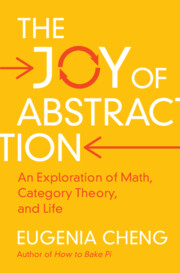Book contents
- Frontmatter
- Dedication
- Contents
- Prologue
- Part One Building up to Categories
- 1 Categories: the idea
- 2 Abstraction
- 3 Patterns
- 4 Context
- 5 Relationships
- 6 Formalism
- 7 Equivalence relations
- 8 Categories: the definition
- Interlude A Tour of Math
- Part Two Doing Category Theory
- Epilogue Thinking categorically
- Appendices
- Glossary
- Further Reading
- Acknowledgements
- Index
3 - Patterns
from Part One - Building up to Categories
Published online by Cambridge University Press: 13 October 2022
- Frontmatter
- Dedication
- Contents
- Prologue
- Part One Building up to Categories
- 1 Categories: the idea
- 2 Abstraction
- 3 Patterns
- 4 Context
- 5 Relationships
- 6 Formalism
- 7 Equivalence relations
- 8 Categories: the definition
- Interlude A Tour of Math
- Part Two Doing Category Theory
- Epilogue Thinking categorically
- Appendices
- Glossary
- Further Reading
- Acknowledgements
- Index
Summary
A discussion of the role of pattern spotting in mathematics. This chapter still has little formality. The idea is that, in math and also in life, we might make abstract versions of things, then spot patterns in them or in common between different situations, and then ask if those patterns are caused by some abstract structure. We begin with some pattern spotting in number squares, and introduce the arithmetic of the 12-hour clock and look at the patterns on its addition table. We discuss patterns as analogies between situations, and discuss the relationship between visual patterns and abstract patterns, one example being the visual patterns made by multiples of 3 on a number square (or multiples of other fixed numbers). We introduce systemic power structures in society as another example of patterns caused by abstract similarities. We discuss how abstraction can help us spot patterns, with one example beingthe analysis of contentious arguments in society and politics, many of which follow a similar pattern.
Information
- Type
- Chapter
- Information
- The Joy of AbstractionAn Exploration of Math, Category Theory, and Life, pp. 35 - 43Publisher: Cambridge University PressPrint publication year: 2022
